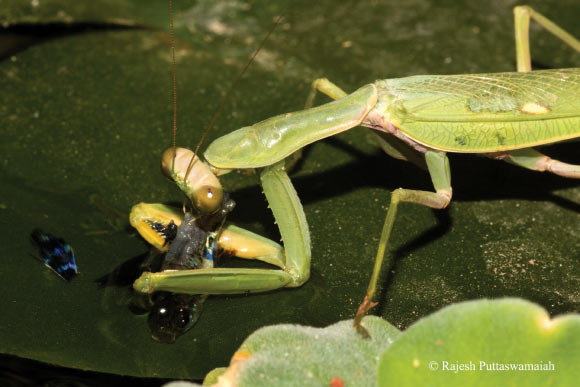Praying mantises are carnivorous insects with powerful raptorial front legs. Their diet includes insects, lizards, frogs, newts, mice, small birds, snakes and turtles. A new study, published in the Journal of Orthoptera Research, adds fish to their menu.

Hierodula tenuidentata eating Poecilia reticulata from the tail. Image credit: Rajesh Puttaswamaiah.
Commonly known to predate on insects, praying mantises have occasionally been observed to feed on vertebrates. Mostly, such records have either not been scientifically validated or have occurred under induced and human-manipulated circumstances.
Nevertheless, no scientific data of mantises preying on fish existed until the new study by Roberto Battiston of the Musei del Canal di Brenta in Italy and his colleagues in India.
Last year, the team observed an adult male of Hierodula tenuidentata hunting and capturing an unusual prey for this kind of insect — the guppy (Poecilia reticulata).
“A 2.2-inch (5.6 cm) male specimen of Hierodula tenuidentata was occasionally observed in a private roof garden in Karnataka, India, preying on guppy fish,” the researchers said.
“The predations were observed every day for five consecutive days from the 7th to the 11th of March 2017 during periodical scans of the habitat from sunset at 6:30 pm to 12:30 am. Therefore, they were unmanipulated and occurred naturally without interference.”
“About 40 fish — mostly Poecilia reticulata and one Hypostomus plecostomus — were contained in an artificial pond made in an earthen planter of 22.8-inch (58 cm) diameter, under natural light conditions.”
“The mantis was able to reach the fish by perching on leaves of water lilies and water cabbage growing on the surface of the pond.”
During the five days, male Hierodula tenuidentata was observed capturing and devouring a total of nine guppy fish.
In seven cases, the mantis started eating from the tail. On a single occasion, he started from the head and on another, from the top side.
On the first four of the five days, the mantis was observed to hunt and devour two fish. The second fish was hunted within 10-30 min of consuming the first one.
After the fifth day, the mantis disappeared and was not observed again at the pond.

The artificial pond with male Hierodula tenuidentata eating Poecilia reticulata. Image credit: Rajesh Puttaswamaiah.
“Apart from being a curious first-of-its-kind, the observation raises three new discussion points worthy of further study,” Dr. Battiston and co-authors said.
“Firstly, the fact that praying mantises hunt on vertebrates outside cages in labs confirms that a single invertebrate species is indeed capable of having an impact on a whole ecosystem. In this case, a mantis preys on guppies which, in their turn, feed on aquatic insects.”
“Secondly, the discovery questions previous knowledge about the visual abilities of mantises. While the structure of their eyes clearly indicates that they have evolved to prey in daylight, the studied male specimen proved to be an excellent hunter in the dark.”
“Besides visual, mantises might have evolved impressive learning abilities too.”
“The observed repetitive behavior might have been the result of personal experience, utilized to navigate the specimen.”
“Sophisticated cognitive skills, on the other hand, might have allowed the mantis to develop its hunting strategies.”
“Remembering the prey’s abundance in a particular site, in relation to their ease of capture and their nutritional content, could be one important factor of this choice and indirectly influence the individual predator’s fitness. This should be investigated in further studies,” they said.
_____
R. Battiston et al. 2018. The fishing mantid: predation on fish as a new adaptive strategy for praying mantids (Insecta: Mantodea). Journal of Orthoptera Research 27 (2): 155-158; doi: 10.3897/jor.27.28067







